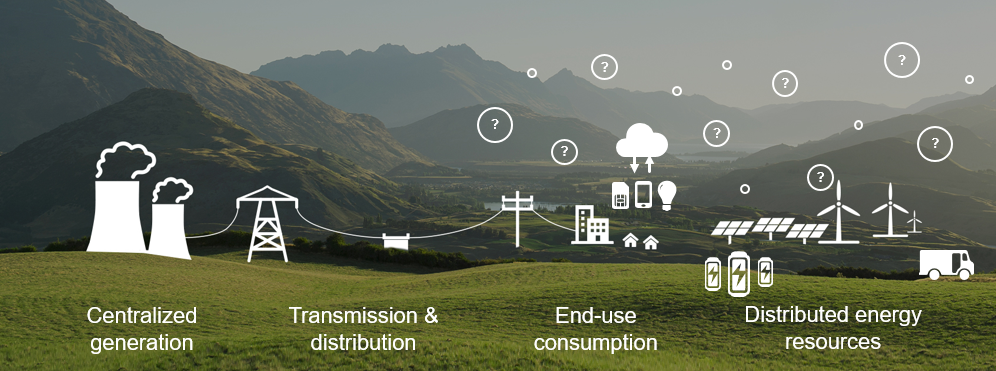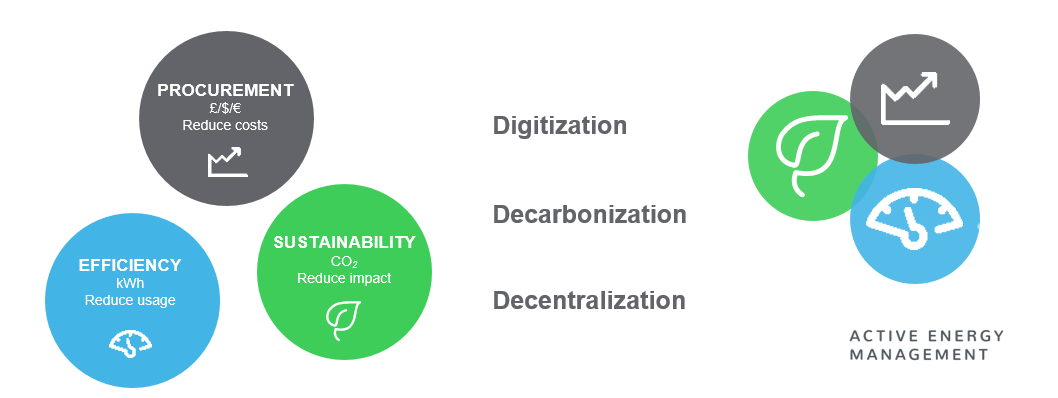Making the Shift to Active Energy Management
55% of clients at the Energy & Sustainability Perspectives Summit revealed lack of organizational alignment as the top factor preventing them from reaching their energy and sustainability goals
The energy landscape is on the brink of disruption. Because of this, forward-looking companies are already hard at work making the necessary adjustments. And it’s important to understand that every organization will eventually need to adapt because of these universal energy trends that are affecting everyone: decarbonization, decentralization, and digitization.
These three trends define the new energy landscape.
But they also bring new opportunities. Energy users will have more control over how they buy and use energy than ever before, and will eventually go beyond simply consuming energy to producing it as well. Advancements in blockchain and peer-to-peer technologies will create an open and efficient method of recording energy transactions in a new, decentralized energy network.
That’s a lot of disruption, and it’s all happening quickly. To make the most of the opportunities presented by this new energy landscape, companies need to make a fundamental change to keep up — a shift to active energy management. Below I’ll go through what active energy management is and the steps you can take to begin making the shift.
Active Energy Management
Active Energy Management is the process of integrating energy supply, energy demand, and sustainability data, programs, and strategies for greater efficiency and maximum results.
Simply put, this means that the procurement officer, operations manager, and sustainability director in an organization need to work together — to form a cohesive strategy, share data, and deploy joint initiatives.
It may be surprising that a trend toward this type of alignment isn’t already universal. But our recent internal survey of clients at the Energy & Sustainability Perspectives Summit revealed that 55% rate lack of organizational alignment as the top factor preventing them from reaching their energy and sustainability goals. Active energy management is the best first or next step for organizations in this position.
Active energy management integrates energy and sustainability decision making, providing a holistic view of the data and resources needed to reduce consumption, drive innovation, and maximize savings.
But how do you get there? How can an organization begin making the shift to active energy management? Here’s where to start.
3 Steps to Begin Active Energy Management
- Get data.
The first step is to obtain information. If you already have access to reliable data, you’re one step ahead. If not, deploying a solution that can harvest accurate energy and sustainability metrics should be a top priority. AEG is a great example of this, as accurate data enables them to manage energy efficiency across dozens of large, disparate, multi-use stadiums. - Make the data useful.
It’s not enough to merely have data. You need a way to accurately extract its meaning. The answer here is software solutions like Resource Advisor, which operates as just that, an advisor to help you reach your energy and sustainability goals.Blackstone leverages reliable analytics to make more than 20 portfolio companies more sustainable. - Upgrade to an integrated strategy.
This third step is the most challenging. It requires that established patterns of decision-making give way to new strategies and new ways of working together within an organization. But it can also be the most rewarding; when a company takes this step, they’ve truly embraced active energy management.
A fundamental change is required, transforming traditional departments into something new, different, and unfamiliar. Right now, many companies have separate departments that decide how to buy energy, how and when to use energy, and how to become more sustainable. But the decision-makers in each of these domains have insights and expertise to offer each other. When energy and sustainability strategies are managed together, blind spots are quickly discovered and new opportunities present themselves.
With energy decision-makers connected and with the right technology in place, an organization has a powerful asset — people working together supported by technologies that work together.
This creates a cohesive team and strategy that are resilient and able to respond to new changes with speed and flexibility.
One of the biggest benefits of our EcoStruxure architecture is its interoperability — our solutions work together across domains. But for connected technology like EcoStuxure to have maximum impact, personnel, programs, and strategies also need to be connected.
In other words, we’re at a time when technological connectivity is in many ways outpacing connection between people and ideas. Shifting to active energy management is the solution to that problem.
Thriving in the New Energy Landscape
In summary, in many organization today energy and sustainability strategies are managed independently with each silo having its own source of data. This inconsistency in data often combines with a lack of cohesion between departments and is leading to missed opportunities.
Companies who want to thrive in the new energy landscape should integrate their energy and sustainability strategies to find new opportunities. We call this Active Energy Management. And it’s the best path to achieving your energy and sustainability goals.
As the new energy landscape emerges, exciting opportunities for innovation are presenting themselves. Those who adopt a forward-looking, integrated energy and sustainability strategy will put their organization in the best position to succeed. Those who delay will be in danger of being left behind.
Learn more about Active Energy Management



